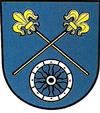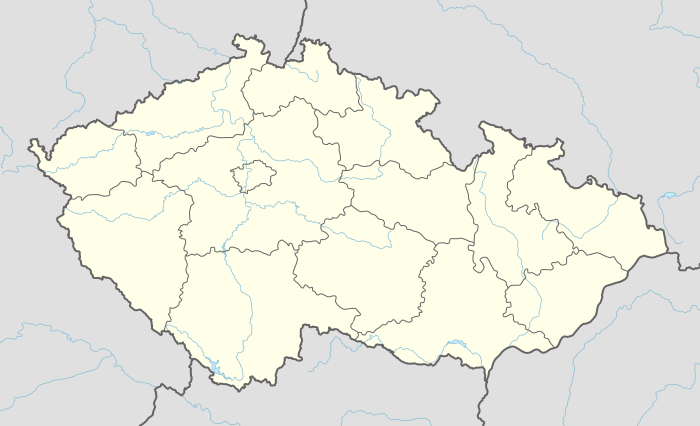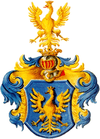Milíkov (Frýdek-Místek District)
![]()
![]()
Milíkov Milików | |
|---|---|
Community center in the village | |
_vlajka.jpg) Flag  Coat of arms | |
 Location in the Czech Republic | |
| Coordinates: 49°35′7″N 18°42′21″E | |
| Country | Czech Republic |
| Region | Moravian-Silesian |
| District | Frýdek-Místek |
| First mentioned | 1577 |
| Government | |
| • Mayor | Eva Kawuloková |
| Area | |
| • Total | 9.15 km2 (3.53 sq mi) |
| Elevation | 420 m (1,380 ft) |
| Population (2019)[1] | |
| • Total | 1,357 |
| • Density | 150/km2 (380/sq mi) |
| Postal code | 739 81 |
| Website | http://www.obecmilikov.cz/ |
Milíkov is situated on the foothills of the Moravian-Silesian Beskids, the mountain of Kozubová lies in the cadastrial area of the village. Near one-third of the village's area is covered by forest and two-thirds are part of the Beskydy Landscape Protected Area.
The name of the village is of possessive origins derived from personal name Milik.[3]
History
The village was first mentioned in 1577 as Milikuw.[3][4] It belonged then to the Duchy of Teschen, a fee of the Kingdom of Bohemia and a part of the Habsburg Monarchy.
After Revolutions of 1848 in the Austrian Empire a modern municipal division was introduced in the re-established Austrian Silesia. The village as a municipality was subscribed to the political district of Teschen and the legal district of Jablunkau. According to the censuses conducted in 1880, 1890, 1900 and 1910 the population of the municipality grew from 676 in 1880 to 771 in 1910 with a majority being native Polish-speakers (99.3% in 1880, then 100%) accompanied by 5 German-speaking in 1880. In terms of religion in 1910 the majority were Protestants (62.1%), followed by Roman Catholics (37.9%).[5] The village was also traditionally inhabited by Cieszyn Vlachs, speaking Cieszyn Silesian dialect.
After World War I, fall of Austria-Hungary, Polish–Czechoslovak War and the division of Cieszyn Silesia in 1920, it became a part of Czechoslovakia. Following the Munich Agreement, in October 1938 together with the Zaolzie region it was annexed by Poland, administratively adjoined to Cieszyn County of Silesian Voivodeship.[6] It was then annexed by Nazi Germany at the beginning of World War II. After the war it was restored to Czechoslovakia.
From 1980 to 1990 the village was administratively a part of Bystřice.
References
- "Population of municipalities of the Czech Republic". Czech Statistical Office. 1 January 2019.
- "2001 census data". Czech Statistical Office. 2005. Retrieved December 2, 2009.
- Mrózek, Robert (1984). Nazwy miejscowe dawnego Śląska Cieszyńskiego [Local names of former Cieszyn Silesia] (in Polish). Katowice: Uniwersytet Śląski w Katowicach. p. 118. ISSN 0208-6336.
- Panic, Idzi (2011). Śląsk Cieszyński w początkach czasów nowożytnych (1528-1653) [Cieszyn Silesia in the beginnings of Modern Era (1528-1653)] (in Polish). Cieszyn: Starostwo Powiatowe w Cieszynie. p. 171. ISBN 978-83-926929-5-9.
- Piątkowski, Kazimierz (1918). Stosunki narodowościowe w Księstwie Cieszyńskiem (in Polish). Cieszyn: Macierz Szkolna Księstwa Cieszyńskiego. pp. 267, 285.
- "Ustawa z dnia 27 października 1938 r. o podziale administracyjnym i tymczasowej organizacji administracji na obszarze Ziem Odzyskanych Śląska Cieszyńskiego". Dziennik Ustaw Śląskich (in Polish). Katowice. nr 18/1938, poz. 35. 31 October 1938. Retrieved 1 July 2014.
External links
| Wikimedia Commons has media related to Milíkov (Frýdek-Místek District). |
- (in Czech) Official website

